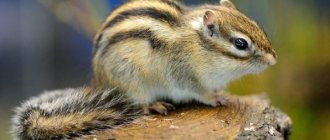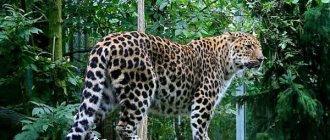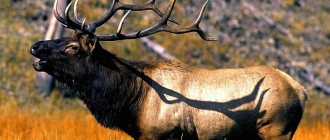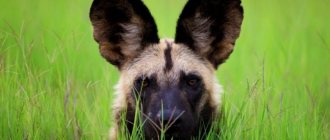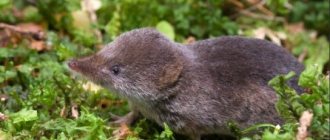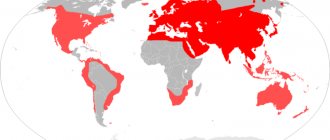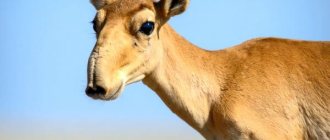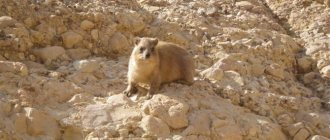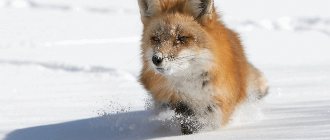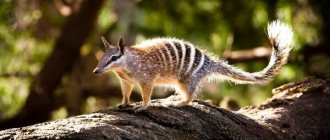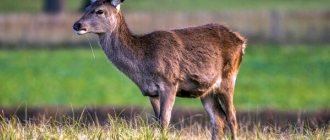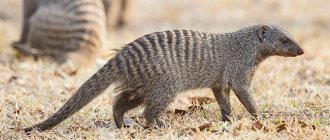Wolverine is a large predatory mammal from the Mustelidae family. Lives in Eurasia and North America. Outwardly, it looks more like a small bear than a marten. The largest terrestrial representative of the genus Mustelidae, the only representative of the genus Gulo.
Known for his ferocity and remarkable strength for his size, he is capable of defeating animals much larger than himself in size.
Description and origin of the species
The first scientific description and name of the animal was given by Carl Linnaeus in 1758. The scientist named the animal Gulo gulo
. In the Mustelidae family, the predator is separated into a separate monotypic genus Gulo, that is, it is the only species of Gulo in the genus Gulo.
From Latin, the word gulo translates as glutton, which is a reference to the insatiable appetite of a predator. The animal is also called an insatiable glutton in French ( glouton
) and German (v
elfraß
) languages.
The name "wolverine" comes from the Finnish word rasva-maha ( rasva-maha
), which literally means “fat belly.”
The Finnish word has taken root not only in Russia, but throughout Eastern Europe: in Polish and Czech the animal is called rosomák,
in Hungarian -
rozsomák.
In English, the name of the beast, wolwerine, literally means “little wolf.” In Norway, the animal was long called the mountain cat, fjellfross.
.
In French Canada, the beast is known as carcajou,
a name borrowed from the language of the Canadian Innu Indians.
The closest relatives of the chamomile are the tayra and the marten; they have a common ancestor from Eurasia. There are 2 subspecies of the animal:
- American wolverine ( G. g. luscus
) - Eurasian wolverine ( G. g. gulo
)
Scientific classification
Systematic group of wolverine:
| Domain | Eukaryotes |
| Kingdom | Animals |
| Type | Chordata |
| Class | Mammals |
| Squad | Predatory |
| Family | Musteluns |
| Genus | Gulo Pallas, 1780 |
| View | Wolverine |
| International scientific name | Gulo gulo Linnaeus, 1758 |
What does a wolverine look like?
The wolverine has a muscular, stocky, squat body with short legs. The predator has a large, wide head, an elongated muzzle, small eyes and small rounded ears. The hind legs are longer than the front legs, which is why the animal's back is curved upward. Long curved claws allow the predator to easily climb trees, rocks and snowdrifts. In appearance, the animal resembles a badger or a small bear.
In terms of size, the wolverine is comparable to a medium-sized dog. The length of the body including the head ranges from 65 to 107 cm, plus a tail 17-26 cm long. The animal weighs from 5.5 to 25 kg, individual males can weigh up to 32 kg. The height at the withers varies from 30 to 45 cm. Males are approximately 30% larger than females, and weigh twice as much. European and North American animals are smaller than those in Siberia. The wolverine is the largest land representative of the Mustelidae family, although the European badger can overtake it in size in the fall.
The animal has thick, long, hard fur. The color is dark brown or tinged with black, with a lighter or white stripe on the muzzle, crown and sides to the base of the tail. Wolverine wool has hydrophobic properties, so it does not freeze in the cold. The predator has large feet - 10 cm long, 9 cm wide. When walking, the animal rests on its entire foot, hence the clubfooted gait. But wide feet allow the predator to easily move through deep snow.
Like other mustelids, the wolverine has anal glands that allow it to emit a sharp, unpleasant odor. Animals mark the boundaries of their territory and also use scent to call a partner during the mating season. Because of its pungent, unpleasant odor, the wolverine received the nicknames “skunk bear” and “smelly cat.”
Where does the wolverine live?
Wolverines live primarily in sparsely populated arctic and subarctic regions, in the taiga and tundra of northern Canada, Alaska, Siberia and Scandinavia. The animal can also be found in the European part of Russia, the Baltic countries, the Far East, the northeastern part of China and Mongolia.
In the New World, most wolverines live in Canada and Alaska. In the US, predators have been spotted in the states of Oregon, Idaho, Washington, Wyoming, Montana, Michigan, Colorado, North Dakota, Utah and California.
In Europe, the animal is still found in Finland, Estonia, Lithuania, Latvia, Poland, and Belarus. Individuals have been seen in Ukraine, but there is no information about a stable population in this country.
In the European part of Russia, the wolverine lives on the Kola Peninsula in the Murmansk region, in Karelia, in the Leningrad, Pskov and Novgorod regions, in the Komi Republic and Udmurtia. The animal can also be found in the Kirov and Tver regions, Perm region, Vologda region. Most of the Russian population of the predator lives in Siberia, the Far East and Kamchatka.
Natural habitat
Wolverines are found in alpine forests, tundra, open grasslands, and transition zones at the forest edge. Sometimes they can be found in swamps. However, they avoid water , although they are very good swimmers.
Photo: Xavier Rufray
Typically, wolverines live in areas with low levels of human presence and require large, undisturbed areas. These carnivorous mammals live exclusively in areas with cold climates, which may be due to their dependence on large animal prey. Cold weather helps preserve meat for later use.
What does a wolverine eat?
The wolverine feeds primarily on carrion, especially in winter and early spring. Predators often follow the tracks of a lynx or wolf, picking up the remains of their prey, or fight off prey from other animals. Wolverine is known for its insatiability - regardless of whether it is fresh prey or carrion, the beast fills its belly to the bitter end. Therefore, the nickname “glutton” stuck to the animal. Greed when eating is most likely due to the harshness of living conditions and the scarcity of prey, especially in winter.
Despite their penchant for eating carrion, wolverines themselves are excellent hunters. They primarily hunt small to medium-sized mammals, but the wolverine is known for being able to kill prey several times its size. The prey of a predator is often:
- porcupines
- squirrels
- beavers
- rodents - chipmunks, marmots, gophers, mice, rats, voles, lemmings,
- moles
- hares and rabbits
- shrews
- deer - reindeer (caribou), roe deer, white-tailed deer, black-tailed deer, elk, elk
- goats and rams
- birds - wild geese, partridges, black grouse, hazel grouse
Wolverine does not miss the opportunity to hunt smaller predators - marten, mink, fox, weasel, ferret, Eurasian and Canadian lynx, coyote and young wolf cubs. The predator prefers easy prey - young cubs, animals caught in a trap, weakened by disease, hunger, or stuck in the snow. The animal often supplements its diet with fish, bird eggs, honey, berries, insects, seeds, roots and plants.
Wolverines in Eurasia often hunt on their own rather than feed on carrion. Since there are fewer large predators in Eurasia than in North America, the animal has less chance of stumbling upon carrion or fighting off prey from a competitor, so it has to hunt itself. The animal often feeds on scraps from wolves, so changes in the wolf population could affect the wolverine.
The predator often hides prey in reserve so that they can return to it later. This is especially true for nursing females in winter and early spring, when there is little food around.
Eating habits
The wolverine's diet can include anything from small eggs to large ungulates. Their diet depends primarily on the time of year, weather conditions and location. In winter, the predator becomes very aggressive and hunts all mammals, including reindeer, roe deer, wild sheep, moose, deer and red deer.
Animals also readily reclaim carcasses killed by other large predators. Wolverines are extremely strong and aggressive for their size, often fighting off bears, cougars and even packs of wolves from their kills. They even eat the carcasses of whales, walruses and seals.
In summer, the main ingredients in the wolverine's diet are bird eggs, tree branches and blueberries. In autumn, the animal eats a huge number of wasp larvae, small rodents, fish and carrion.
While raising their young, female wolverines typically hunt smaller animals such as rabbits, hares, ground squirrels, marmots, and lemmings. The amount of food available can be key to population size; more food leads to greater reproductive success.
Character and lifestyle features
Wolverine leads a solitary lifestyle and lives in its own territory. Males usually have huge territories, ranging from 620 square kilometers. The territory of the female is noticeably smaller, from 130 to 260 square kilometers. Several females live on the male’s territory, while the areas of individuals of the same sex practically do not overlap with each other. Wolverine actively roams its territory in search of prey, and can travel hundreds of kilometers in a few months.
The animal hunts mainly at dusk. During the day, the beast makes a lair under uprooted tree stumps, in caves and rock crevices. The wolverine has keen eyesight, good hearing and sense of smell. The animal is excellent at climbing rocks and trees, and can swim quite well.
In character, the wolverine is similar to its southern relative, the honey badger. The animal is distinguished by its ferocity and fearlessness, and is capable of attacking a superior enemy without hesitation. Even large predators, such as bears, try to avoid the beast and not anger it unnecessarily. Wolverine can successfully hunt prey that is 5 times the weight of the predator itself.
Another member of the mustelid family is the honey badger.
This is an exceptionally aggressive and fearless animal. It is even smaller in size than a wolverine, similar to a small badger. In the film (zoology has nothing to do with it, the film is a feature film) “The Gods Must Be Crazy - 2” a significant part of the narrative is devoted to the honey badger, and the character of this little predator is especially well shown there. The main character accidentally pushed the animal with his shoe, and the honey badger became furious. It had a death grip and it was impossible to get rid of it. So the hero dragged him for many, many days through the desert. This dangerous animal did not let go of the shoe, even fainting from hunger and dehydration, and when they managed to tear it off and move forward, the honey badger still stood up and, stumbling and falling, ran after the hero. That's what character means!
However, the honey badger is much better equipped for combat than the wolverine. This African animal fearlessly attacks lions, buffaloes and any other animals that seem not polite enough to it. The honey badger's skin is unusually thick. Even a porcupine's quill cannot pierce it, and no one can bite through it. Moreover, his skin is like a fur coat on a person, in which he can turn his body, even rotate it. The honey badger’s skin exists as if separately from the rest of its body, protecting it with a shell and not interfering with movement, what an interesting animal it is. Try this one! He will turn around and bite and tear anyone to pieces. That's why the honey badger has the sharpest teeth in its mouth and the strongest claws on its front paws.
Reproduction and young
Wolverines are characterized by polygamy. The strongest and most successful males form stable relationships with 2-3 females, whom they visit in turn, while the remaining males are left without females. Females give birth once every 2 years. The mating season occurs in the summer, from May to August. The fertilized egg does not immediately enter the uterus. Fetal development is usually delayed until early winter; in lean years it does not occur at all.
Pregnancy lasts about 30-50 days, after which 2-3 blind cubs are born in February-March. Newborn wolverines weigh about 100 grams. Eyes open at 4 weeks. During the first 10 weeks, while the mother feeds the cubs with milk, the fathers often visit them.
At the age of 3 months, the cubs begin to leave the den. After 6 months, young wolverines are often reunited with their father and travel together for a while. Kittens grow quickly, and within a year they reach the size of an adult. Up to 2 years old, grown kittens stay close to their mother, then go into independent life.
Natural enemies
The wolverine's most implacable enemies in the wild are wolves. The appearance of a pack of wolves in a wolverine's territory usually results in the predator having to leave its territory in favor of the pack. In both Eurasia and North America, wolves account for the majority of natural animal deaths. Wolverines are strong and powerful animals, and can cope with one wolf, but they cannot fight an entire pack.
In North America, the second serious opponent for the animal is the puma. Unlike wolves, cougars do not specifically hunt wolverines, but they act as serious competitors and can take prey away from the predator. Prey is also often taken from the animal by bears, and in a fight with a bear the wolverine's chances are small.
Hunting
Rarely does anyone manage to see this animal and hear a wolverine scream, because this animal is secretive and extremely cautious. Not everyone, even the most experienced hunter, will deliberately hunt wolverine. The fact is that, thanks to its developed intelligence, the animal bypasses traps placed in places where the wolverine lives and easily escapes the chase. She is not afraid of dogs and, thanks to her strength, agility, powerful jaws and sharp claws, she almost always emerges victorious from a fight with a dog.
In rare cases, a pack manages to drive an animal into a tree and keep it there until the hunter arrives; As a rule, the prey are very young animals.
Sometimes hunters set traps right in the hut if they go away for a long time. Wolverine, known for his nasty character, will not miss an opportunity to get in there to steal something from supplies or just to cause mischief.
Using poison in baits is useless. Thanks to its keen sense of smell, the animal senses the smell of chemicals and does not accept such bait.
Some fishermen use a homemade trap - a pinch-rod, over which the bait is suspended. Trying to get the bait, the predator climbs onto the plane, gets its paws between the poles, pinches itself with its weight and cannot get out of there.
Most often, a wolverine becomes prey completely by accident when hunting other game.
Wolverine is a valuable and rare trophy; this animal is not easy to find in the forest, much less to catch.
Population and protection of the species
The wolverine is listed as a species of Least Concern on the IUCN Red List of Threatened Species due to its wide range and large population. In Russia, the wolverine is listed in the regional Red Books of the Leningrad and Murmansk regions, Udmurtia and Karelia.
The exact number of individuals in the world is unknown due to the low population density and huge habitat of the animal. The largest and most stable population, according to experts, is in Canada - about 16,000 - 19,000 individuals. In Sweden and Norway there are at least 1,000 individuals, in Finland - up to 200 animals.
Up to 1.5 thousand animals live in the European part of Russia, and their number is steadily decreasing due to a decrease in habitat and climate warming. It is unknown how many other animals live in Siberia, the Far East and Kamchatka, but the Siberian and Far Eastern populations should be much more stable than in the European part of the Russian Federation.
There are about a hundred animals in zoos around the world. Wolverines have difficulty breeding in captivity and are subject to high infant mortality rates.
The main risks for the animal population:
- global warming . Female wolverines make a den in the snow in February and raise their cubs in it until May. Therefore, animals prefer areas where snow remains until the end of spring.
- reduction of habitat . Wolverines need a huge territory, while their habitat is increasingly shrinking due to human expansion.
- hunting _ Wolverine fur is quite rare, and highly prized because it does not tan. The animal often becomes a victim of hunters and poachers.
Nutrition
Information about what wolverine eats will also be interesting. The animal can eat dead animals without any problems, however, despite this, it is an excellent hunter. It can catch both a small hare and small representatives of ungulates. Excellent endurance allows him to chase even a deer for several days, obtaining the desired prey after a certain time. Most often this happens in winter, when the wolverine can drive its prey into a snowdrift, while thanks to its feet it will not fall into the snow, and there it can finish off its prey. Situations often arise when a wolverine tries to take food from another animal, and it should be noted that she succeeds in this not so rarely, but all thanks to her teeth and claws. It will also be interesting that this animal is considered a forest orderly and has gained a bad reputation among hunters, because it can independently rescue animals from a trap in order to feast on them.
